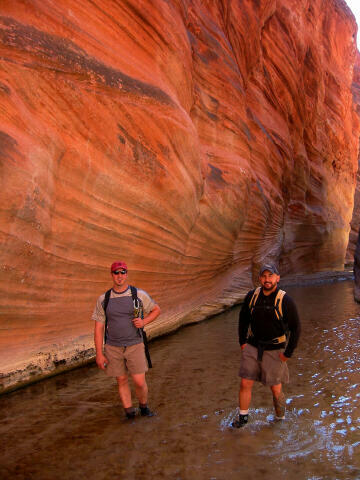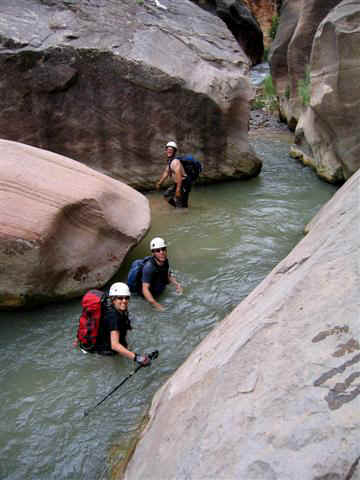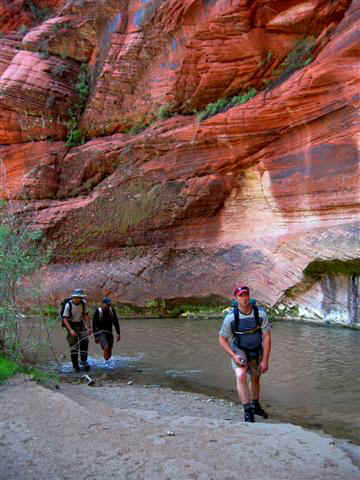[ Homepage
] [ Introduction ] [ Warning ] [ Ratings
] [ Ethics ] [ Feedback ] [ Updates
]
 |
Parunuweap Canyon
AKA: The Barracks
Zion National Park
Canyoneering & Backpacking
Take the famous Zion Narrows,
remove the training wheels, and you have a good impression of Parunuweap Canyon. This
canyon is just as spectacular as it's big brother, but is more remote, seldom visited,
contains a poorly marked route and is more difficult.
This route follows the East Fork of the Virgin River into Parunuweap Canyon, also known as
"The Barracks". This is one of the more dramatic and foreign canyons in southern
Utah. The route contains no technical barriers and can be completed by experienced hikers
and backpackers. Good navigation skills are a prerequisite for this route. |
Circle of Friends:
Parunuweap
Canyon is part of the "Circle of Friends"
program. Members of the "Circle of Friends"
have access to more specific information, explicit route information, GPS waypoints,
trailhead location and detailed maps. If
you would like more information on joining the "Circle of
Friends" visit the sign up page.
"Circle of Friends"
General Information:
Parunuweap Canyon is a
canyoneering adventure that will require 10 to 14 hours to complete for experienced
hikers. The total route is 18 1/2 miles long, which does not include side canyon
exploration. This route is commonly done as a two or three day backpack, which allows more
time to explore and admire the scenery. Parunuweap Canyon is rated 2C IV using the Canyon
Rating System. No Zion backcountry permit is required since the overnight portion
of this route is located outside the National Park Boundary.
Navigation for this adventure is difficult, and requires
several miles of travel over open terrain. A GPS is very useful. Good map reading skills
are essential. There is no real trail and several miles of overland
navigation is required to complete this route. You will be walking and wading in a canyon
bottom for most of this trip.
Trailhead information:
A car shuttle is required
for this complete adventure. A passenger car can easily access the required trailheads in
all weather conditions.
Sneak-N-Peek Route:
A popular 7 to 8 hour Sneak-N-Peek route
also exists into Parunuweap Canyon. The Sneak-N-Peek will give you an enjoyable sojourn to
a unique and seldom explored canyon. The Sneak-N-Peek route will allow you to visit the
Powell Plaque, Labyrinth Falls, Misery Canyon and the deepest
section of Parunuweap Canyon. No shuttle vehicle is required when using the Sneak-N-Peek
route.
Powell Plaque Inscription Reads:
"Major John Wesley
Powell 1834-1902 explorer, scientist, Steven V. Jones 1840-1920 teacher, topographer,
Joseph W. Young 1829-1873 Mormon pioneer leader, Descended Labyrinth Falls 1/2 mile below
Monday, September 30, 1872 during first Parunuweap Canyon traverse. Powell named this
canyon from the Paiute Indian word 'Parunuweap' which means roaring water canyon.
Dedicated September 30, 1972."
History:
John Wesley Powell first
visited and documented Parunuweap in September 1870 during early exploration. Powell named
the canyon "Parunuweap", a Paiute term that translates as "Roaring Water
Canyon". The following excerpts are from Powell's journal.
September 10 -- The Indian name of the canyon is Paru'nuweap, or Roaring Water
Canyon. Between the little river and the foot of the walls is a dense growth of willows,
vines, and wild rosebushes, and with great difficulty we make our way through this tangled
mass. It is not a wide stream-- only 20 or 30 feet across in most places; shallow, but
very swift. After spending some hours in breaking our way through the mass of vegetation
and climbing rocks here and there, it is determined to wade along the stream. In some
places this is an easy task, but here and there we come to deep holes where we have to
wade to our armpits. Soon we come to places so narrow that the river fills the channel and
we wade perforce. In many places the bottom is a quicksand, into which we sink, and it is
with great difficulty that we make progress. In some places the holes are so deep that we
have to swim, and our little bundles of blankets and rations are fixed to a raft made of
driftwood and pushed before us. Now and then there is a little flood-plain, on which we
can walk, and we cross and recross the stream and wade along the channel where the water
is so swift as almost to carry us off our feet and were are in danger every moment of
being swept down, until night comes on. Finding a little patch of flood-plain, on which
there is a huge pile of driftwood and a clump of box-elders, and near by a mammoth stream
bursting from the rocks, we soon have a huge fire. Our clothes are spread to dry; we make
a cup of coffee, take out our bread and cheese and dried beef, and enjoy a hearty supper.
We estimate that we have traveled eight miles to-day.
The canyon here is about 1,200 feet
deep. It has been very narrow and winding all the way down to this point.
September 11 --
Wading again this morning; sinking in the quicksand, swimming the deep waters, and making
slow and painful progress where the waters are swift and the bed of the stream rocky.
The canyon is steadily becoming
deeper and in many places very narrow-- only 20 or 30 feet wide below, and in some places
no wider, and even narrower, for hundreds of feet overhead. There are places where the
river in sweeping by curves has cut far under the rocks, but still preserves its narrow
channel, so that there is an overhanging wall on one side and an inclined wall on the
other. In places a few hundred feet above, it becomes vertical again, and thus the view to
the sky is entirely closed. Everywhere this deep passage is dark and gloomy and resounds
with the noise of rapid waters. At noon we are in a canyon 2,500 feet deep, and we come to
a fall where the walls are broken down and huge rocks beset the channel, on which we
obtain a foothold to reach a level 200 feet below. Here the canyon is again wider, and we
find a flood-plain along which we can walk, now on this, now on that side of the stream.
Gradually the canyon widens; steep rapids, cascades, and cataracts are found along the
river, but we wade only where it is necessary to cross. We make progress with very great
labor, having to climb over piles of broken rocks.
[ Homepage
] [ Introduction ] [ Warning ] [ Ratings
] [ Ethics ] [ Feedback ] [ Updates
]
© Copyright
2000-, Climb-Utah.com |








